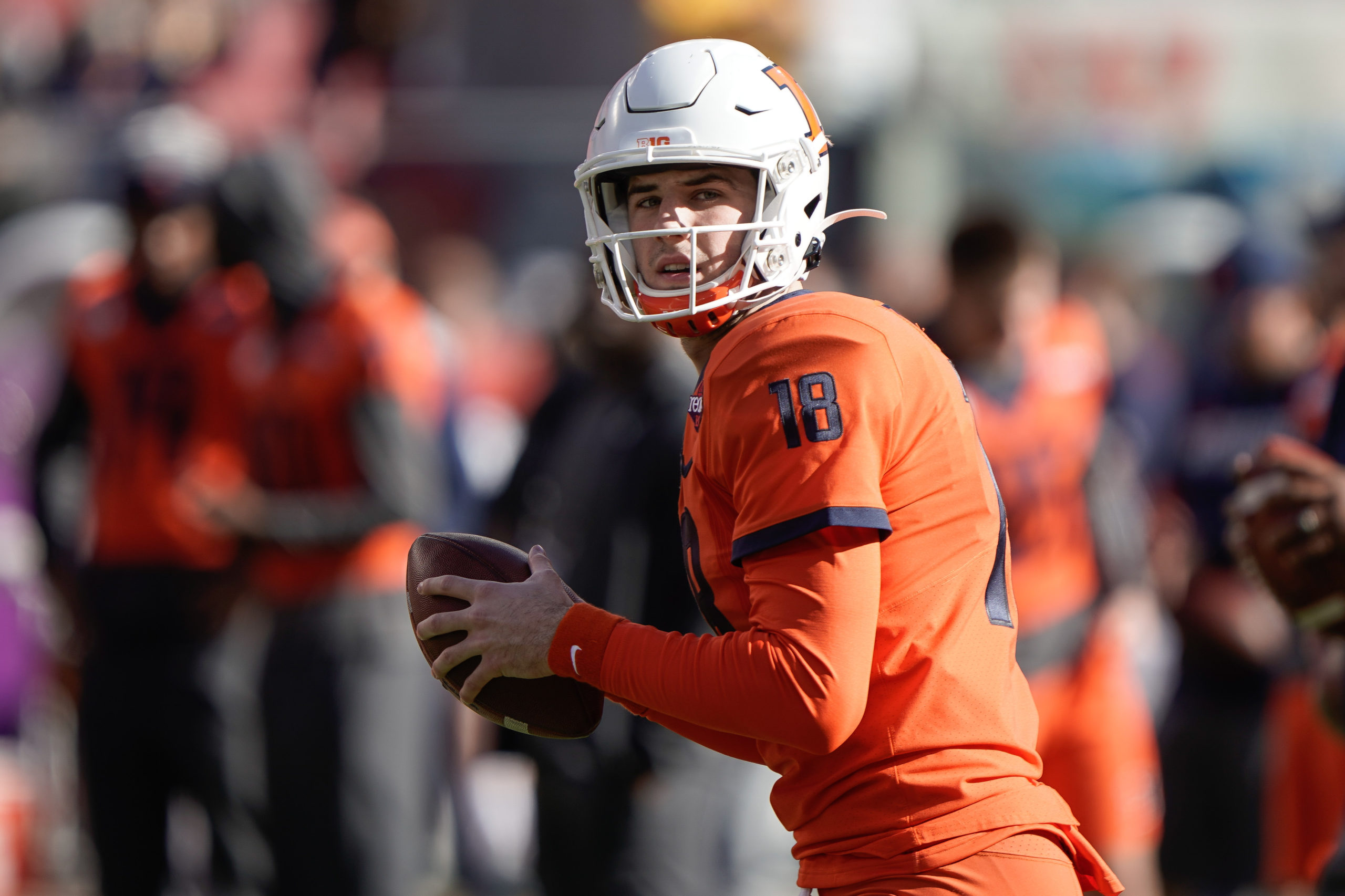Ad Disclosure

The Illinois offense was as Jekyll and Hyde as any in the Big Ten, especially in the second half of 2019. Even though Illinois finished with its highest points per game average (26.7) in 5th-year head coach Lovie Smith’s tenure, it always left fans wanting a little more.
That’s because there were impressive barrages, followed by droughts. The most striking example was when Illinois piled up 27 4th-quarter points in a riveting comeback win at Michigan State, which was preceded by a 38-point outburst against Rutgers. But in a subsequent 3-game losing streak to close the season, the Illini scored only 40 points total.
With the COVID-19 pandemic canceling most, if not all, of spring practice around the country, continuity could be even more critical than usual in 2020. Illinois is set up well in that regard. According to Bill Connelly’s annual returning production ratings, Illinois has 86 percent of its offensive production back, which is the 11th-most in the country.
But the bar has to be much higher for this offense than ranking 115th in the country in total offense and 116th in yards per play, as it did in 2019. One of the trickiest things to duplicate year to year is defensive turnovers, since those can be quite flukey. Illinois can’t count on its defense to finish 4th in the country again in that category, which means the offense needs more consistent production if it is to reach a bowl game for the 2nd consecutive season. That would be notable. The Illini have been to bowls in back-to-back seasons just once in the past 27 years — in 2010-11 under Ron Zook.
So, can Illinois take another step forward after finishing 8th in the Big Ten in points? There certainly is room to grow after averaging only 329.5 yards per game and 5 yards per play.
Passing offense: Better
The reason for any optimism starts and ends with one of the conference’s top returning duos in quarterback Brandon Peters and wide receiver Josh Imatorbhebhe. Both were highly regarded recruits, then high-profile transfers (Peters spent 2 seasons at Michigan and Imatorbhebhe began his career at USC) and now both are productive Big Ten players.
Imatorbhebhe, in particular, emerged as a go-to target in finishing 5th in the Big Ten with 9 touchdown receptions. (Illinois only threw 19 TD passes all season.) He is the league’s 7th-leading returning receiver in 2020. He has chemistry with Peters, and that, as mentioned above, will be an even greater luxury than usual thanks to the pandemic.
Illinois needs a second wideout to emerge, whether that’s Trevon Sydney (USC transfer who missed most of 2019 with a hamstring injury) or Donny Navaro (who started after Sydney went down in the fifth game). The Illini have a strong tight ends group, as Daniel Barker averaged over 15 yards per reception with four touchdowns. Georgia transfer Luke Ford, the No. 3 tight end in the 2018 class, is one to watch as he sat out last season after failing to get a waiver. It will be interesting to see how the Illinois native is used.
The key, though, is Peters, a former 4-star QB who was ranked ahead of the likes of Dwayne Haskins and Justin Herbert out of high school. He has the talent, but the production hasn’t quite been there in comparison to other high-profile transfer quarterbacks. On a scale of Hunter Johnson to Justin Fields, Peters is somewhere in the middle. Not bad, but not really good either. If he makes a leap in his second season as the starter, Illinois’ ceiling goes up by a few wins.
Running game: Better
Illinois lost its top 2 rushers from 2019 in Reggie Corbin and Dre Brown. Mike Epstein, the presumed 2020 starter, is coming off an ACL injury and the presumed No. 2 back is a MAC transfer. So it is strange to think the Illini will be better running the ball in 2020?
It’s really not.
The root of any good running game is up front, and Illinois returns 4 of 5 starters on the offensive line. And the likely 5th starter, Wofford transfer Blake Jeresaty, was an FCS All-American. Plus the Illini will have Ford, as mentioned above, as a weapon in the run game with his 6-6 frame.
Epstein has averaged 6.4 yards per carry in 13 career games, and he’ll be plenty capable if he can just stay healthy. Western Michigan transfer Chase Brown also flashed his ability with the Broncos.
That said, there is a world in which “Lovie Ball” doesn’t generate as many turnovers as it did in 2019, and as a result, Illinois is playing catch-up. That means more passing situations and fewer running opportunities. It remains to be seen whether Illinois will rack up as many yards, but the hunch here is that it is more efficient than the 3.8 yards per carry it averaged last year.
Special teams: Even
While James McCourt will always have a special place in fans’ hearts after his game-winning kick against undefeated Wisconsin, he ranked just 82nd out of 100 qualified kickers in making 68% of his field-goal attempts. He does have a year of experience, though, and that matters in terms of psyche. Sometimes kicking is like golf and free-throw shooting — all mental.
Illinois was 5th in average return yards on kickoffs, thanks in large part to the departed Dre Brown.
Overall: Better
It’s all relative. There’s no reason to believe that Illinois is going to be some offensive juggernaut, but it’s certainly plausible for it to expect to take a step forward and build on some of the promise it showed in spurts last season.
With so much experience returning on the offensive line, a 2nd-year starter at quarterback and a rising star at wideout, it would be a disappointment if the Illinois offense didn’t show some sort of improvement.
Ryan O'Gara is the lead columnist for Saturday Tradition. Follow him on Twitter @RyanOGara.